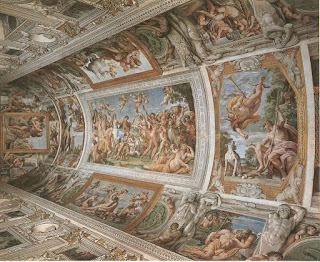The Last Communion of Saint Jerome is considered the greatest work of Agostino Carracci -- the eldest brother of Annabile Carracci and founding member of the Carracci Academy -- and a clear illustration of the Carricci philosophy in opposition to Mannerism. I evaluate the painting in this post.
 |
The Last Communion of Saint Jerome, 1592 - 97
Agostino Carracci |
The Subject
The painting depicts the Last Communion being given to Saint Jerome by Saint Eusebius. It is based on one of three apocryphal letters from Eusebius to the Pope wherein he "recounts" the administration of the Eucharist just prior to Jerome's death.
Saint Jerome (347 - 420) was born in Dalmatia (modern-day Croatia) but moved to Rome during his teenage years. He was baptized as a Christian in Rome and, thereafter, embarked on a life of religious study, writing, translation, and ascetism. Included in his accomplishments were the roles of advisor to Pope Damasus I and the translation of the Latin Vulgate Bible (the New Testament from Greek to Latin and the Old Testament from Hebrew to Latin). Jerome relocated to Palestine on the Pope's death and set about establishing monasteries for men and and women while living, studying, and writing in his cell.
The Artist
Agostino Carracci started out as a goldsmith's apprentice but turned to painting and was trained, initially, by Prospero Fontano, and then by Passerotti and Domenico Tibaldi. He worked as a reproductive engraver in the late 1570s and visited Venice and Parma in the 1580s before returning to Bologna to aid in the founding of the Carracci Academy.
Agostino and his brother Annabile returned to Bologna tours of Northern Italian painters and collaborated with their cousin Ludovico in the formation of an academy focused on teaching art. The Carracci used the academy to "promote the idea that art should draw directly from nature for its study," an idea that was a direct refutation of Mannerism's focus on complexity and artificiality.
The key innovation for the Carracci was the melding of the design characteristics of Florentine art with the colors of Venetian art and their naturalism into a style that was characterized by clear, simple, direct imagery. This style comported well with the guidelines established by the Council of Trent and was enthusiastically endorsed in Rome. It is thus no coincidence that the Carracci came to dominate the religious art scene and their works began to show up in many churches, chapels, and cathedrals.
They worked together on the Palazzo Fava in 1583 and the Palazzo Magnani in 1590-92.
The Painting
The painting was commissioned in 1590 by Certosa di Bologna, a former Carthusian monastery located just outside the city walls and dedicated to Saint Jerome.
The painting is centered on a blue-and-gold-robed Saint Eusebius preparing to administer the Eucharist to an emaciated Saint Jerome who is, in turn, being supported by two monks. I have annotated the painting in the figure below in order to highlight my observations.
 |
The Last Communion of Saint Jerome, 1592 - 97 (annotated)
Agostino Carracci |
The representation falls well within the high-renaissance tradition, in keeping with the Carracci refutation of the Mannerist style. It also adheres to the dictates of the Council of Trent by telling a religious (-associated) story simply and clearly (The apocryphal nature of the underlying story may be a departure from the Trent strictures, however.).
The picture was very naturalistic in its representation of the figures (a Carracci feature) but did not show the vibrancy of color, another attribute of their style.
Other Treatments of this Topic
Sandro Botticelli and Domenichino both painted versions of this topic.
Sandro Botticelli
Botticelli's version was painted between 1494 and 1495, 100 years prior to Carracci's effort and during the time when he was painting religious rather than mythological subjects.
The scene is set in the mid-ground of a church-like structure which is open on the side facing the viewer. As in the case of the Carracci effort, there are two groups, but the number in each group is smaller in this case. The figures in the composition, as in the Carracci case, take up about one-half of the vertical space. The composition falls within the framework of an upturned bowl. Further, Saint Jerome is attended by monks while Saint Eusebius is attended by Altar Boys.
The symbolic candles and Cardinal's hat are included in the painting. The figure of Jesus on the Cross is almost hidden in the palm fronds jutting upwards from the altar. The painting also includes a great representation of differential textures in the fabrics between the two saints.
 |
The Last Communion of Saint Jerome, 1494 - 95
Sandro Botticelli |
Domenichino
The Domenichino effort was painted approximately 20 years after Carracci's version. This work was commissioned by the congregation of San Girolamo and was Domenichino's first public commission for an altarpiece. He was paid 254 scudi for the effort.
There is a degree of similarity between the two paintings, some of which is masked by the differing color scheme and the reversal of the figures.
Domenichino had been a student of the Carracci in Bologna and had traveled to Rome along with a number of other students to assist Annibale Carracci in the painting of the Farnese Gallery frescoes. One of those students -- Giovanni Lanfranco -- accused Domenichino of stealing ideas for his painting from the Carracci painting.
 |
The Last Judgment of Saint Jerome, 1611 - 14
Domenichino |
Painting Provenance
This painting was taken -- along with works by Antonio and Bartolomeo Vivarini and Ludovico Carricci -- to Paris by Napolean. Upon its repatriation, it was deposited in the Pinacoteco Nazionale.
©EverythingElse238

























